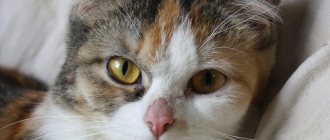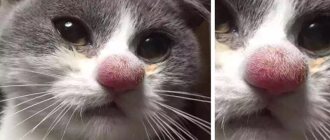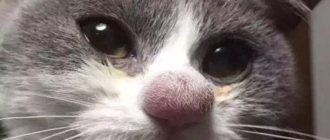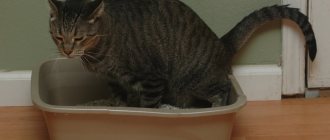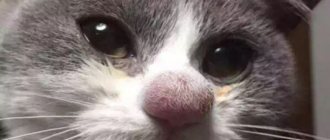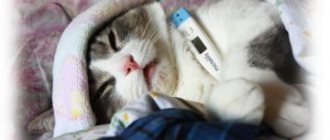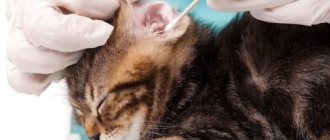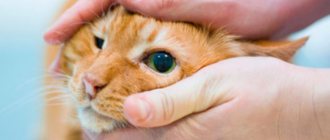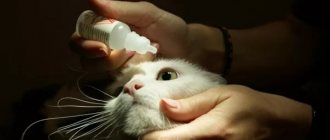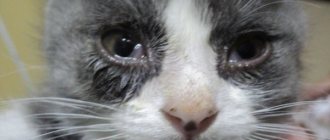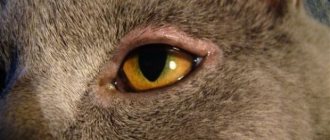Have you noticed changes in your pet? The eye is swollen, the cat often rubs its face, and tears flow from the corners? In this article, we will tell you what diseases and causes may cause ophthalmological problems in your pet, what you can do and what preventive measures will help you maintain your cat’s health.
The eyes are the main sensory organ through which cats perceive the outside world. Nature has endowed cats with acute vision (six times sharper than that of humans), and sometimes by looking into them, we can see the entire Universe.
This sense organ is not only the dignity and adornment of a beautiful animal, but also one of its weakest points. Very often, pets develop diseases that put the clarity and health of their vision at risk. It is important for every responsible owner to know what a pet’s healthy eyes look like and for what symptoms it is necessary to take it to the veterinarian.
Eye swelling in cats can signal a potential problem.
The cat's eye is swollen
Swelling of this organ is one of the main symptoms of most eye diseases. The main thing is not to ignore it, hoping that it is just temporary and everything will go away on its own. So, what to do?
What could be the consequences of ignoring this problem? For example, to loss of vision, which affects the behavior, activity and mood of your pet. Perhaps you think that everything is quite simple, the cat just hit its eye and you need to wait a couple of days? I hasten to inform you that swelling of the eye can signal more complex problems, ranging from internal pathologies to a malignant tumor. Treat this symptom with caution and do not neglect to consult a veterinarian
Causes of eye tumors in cats
Here is a list of diseases why such a symptom as swollen eyes appears in a cat:
- Trauma or bruise
- Foreign body
- Entropion (etripon)
- Conjunctivitis
- Keratitis
- Eye damage by helminths
- Tumor
Each disease has additional symptoms that can indicate the nature of the problem and ways to solve it. We will talk about them below.
Pay attention to your pet's behavior - this will help you more accurately identify the problem.
Kittens' eyes fester and stick together: treatment with traditional methods
There are many ways to cure eye infection in a kitten. The treatment method depends on the original cause. When using the same medications for different ailments, treatment may be ineffective. The easiest way for such purposes is to use neutral agents that will help remove mucus, suppuration, and alleviate the kitten’s condition.
Kittens' eyes fester and stick together, treatment with traditional methods:
- Tea. It is necessary to brew strong tea, without adding fruit, moisten a gauze swab and apply it to the sore eye for a couple of minutes. Wait until the solids are completely dissolved in the tea.
- After this, you need to wipe with a swab from the outer corner of the eye to the inner. After this, you need to take new tampons. New swabs must be used for each eye.
- Chamomile tincture. For these purposes, you need to brew chamomile in the amount of 1 tablespoon of the herb per glass of boiling water. Keep it on low heat for 2 minutes. After this, you need to cool the mixture to a temperature of 20 degrees, moisten a gauze swab or cotton pad in the solution. In the same way, you need to hold it on the kitten’s eyelid for 2 minutes and rub from the outer corner of the eye to the inner one.
Treatment
Injury
If your cat is active, plays a lot, runs and jumps, then the eye may be swollen due to a bruise. And if your pet is very warlike, then most likely he could get damaged in a fight. In any case, you definitely won’t be able to find out on your own, because the cat won’t be able to tell you that it took part in the fight for territory. And cats don't bruise.
If your kitten is acting restless, or you notice swelling, redness or tears, then he is most likely damaged. Cold compresses can help in this case.
Feed your cat food rich in vitamin A, which speeds up the regeneration and restoration of the skin.
If the amount of tear secretions increases, then you should not delay visiting the veterinarian, since during a fight the cat could damage the cornea of the eye. Without timely treatment, your pet may lose the injured eye.
Foreign body
Cats are by nature inquisitive creatures, and exploration and exploration of new territory is the norm for them. Your pet could injure and get debris into its eye while exploring the neighbor's bushes, or even indoor plants.
If you notice that your kitten is blinking frequently, rubbing its eye with its paw, or there is swelling, redness and discharge, then you should do an initial examination. The swelling may be hot to the touch.
When you are convinced that there is a foreign object in the cat’s eye, think several times about whether you should remove it yourself? After all, one awkward move and you can damage your eye irrevocably. It is better to call a veterinarian at home and follow his further recommendations.
If you rarely brush your pet, its own hair can easily get into the eye and cause irritation of the cornea.
Symptoms of swelling of the eyelids above the eyes
Keep in mind! Swelling of the upper eyelids may be accompanied by the following symptoms:
- itching, irritation and burning of the skin above the eyes ;
- change in the color of the skin of the eyelids (it becomes darker or bluish or, on the contrary, turns pale);
- the skin of the eyelids becomes denser to the touch ;
- When closing the eyes, there is a feeling of tension in the eyelids ;
- touching the eyelids causes discomfort or pain ;
- Vessels and capillaries appear on the surface of the eyelids ;
- a small rash may appear.
Other unusual signs or sensations may also appear. When they appear, it is necessary to undergo an examination that will allow you to accurately determine the cause of the swelling.
Entropion (etropion)
This is a pathological condition in which the upper or lower eyelid turns towards the eyeball. This disease can be influenced by various factors: hereditary, acquired or age-related.
There are cat breeds in which the occurrence of entropion is increased (Persian, Maine Coon, Siamese, Sphynx, Scottish, British). This is due to the fact that the ligaments on the inside of the eye are weakened, and with age and decreased immunity, they become even more flabby and the eyes are attacked by viruses and bacteria, which leads to the occurrence of etropion.
In fact, all cats in old age (over 10 years old) are susceptible to this disease, and it can develop in both eyes and affect both the upper and lower eyelids.
Acquired factors include: injuries to the eyeball and other eye diseases (viral, infectious, fungal, neoplasms).
At the initial stage, the symptoms of volvulus can be confused with conjunctivitis: there is a fear of light, frequent blinking, and slight lacrimation. Further, the symptoms worsen: the eyelids swell, become red, the discharge becomes cloudy and increases in size. The Cat loses its appetite and interest in what is happening. With all the symptoms, it is important to know that the animal is feeling increasing pain.
The most important thing here is not to treat your pet’s eyes yourself, but to take them to a veterinary clinic for diagnostics. After all, the eyes are a very sensitive organ; we cannot know for sure that we will not harm the pet with our desire to help right now.
Conjunctivitis
As a rule, this disease is rarely registered as an independent disease. Most often, this is a signal of the presence of other problems: mechanical injuries, infectious diseases, parasitic worms in the eyeball, eyelash growth inside the eyelid (trochiasis), and even incorrectly selected dry food.
Symptoms of conjunctivitis:
- Photophobia;
- Swelling and redness;
- Frequent washing of the face;
- Decreased appetite;
- Discharge (which increases and the eye sticks together).
Reference
In almost 60% of cases of conjunctivitis infection, symptoms appear in only one eye, and after a few days the second eye is involved in the process.
When the first symptoms are detected, to alleviate the condition, you need to provide the animal with rest in a room with dim light, and also rinse the eyes with an antiseptic solution. Next, contact a veterinarian to make a correct diagnosis, conduct diagnostics and prescribe treatment.
There is also a risk for humans of contracting conjunctivitis from a cat.
Keratitis in cats
Another one of the most common ophthalmological diseases in cats. Keratitis is an inflammation of the cornea. You can recognize it immediately by a clouded eye.
This disease can also occur due to other reasons: foreign body, conjunctivitis, eye burns (difficult to treat), allergies, infection, vitamin deficiency, inflammation of the lacrimal glands, genetic predisposition (most often artificially bred cats are prone to this disease - Siamese, Persians, British).
In addition to clouding of the cornea, you need to pay attention to a number of symptoms that will confirm your fears:
- Manifestation of blood vessels;
- Severe photophobia;
- Fluid accumulation inside the eye;
- The appearance of scars (indicates that the disease is at the last stage and further treatment will most likely not bring any results).
As you probably already understood, independent treatment is contraindicated, and first you need to find out the causes of keratitis. You can examine the eye for the presence of foreign bodies, assess the general condition, but only a qualified veterinarian can determine the severity of the disease and prescribe treatment.
Cloudiness of the eyeball indicates the possibility of more complex internal diseases.
How to treat?
When a cat's visual organs are swollen and lumps appear above the eye, it is important to take him to the veterinarian. Self-treatment can cause serious harm to your pet's health. The treatment regimen is selected by the veterinarian depending on what disease has been diagnosed. If the problem is minor and swelling is observed due to inflammation of the mucous membrane, it is recommended to resort to a weak solution of hydrogen peroxide. Dip a cotton swab into the liquid and gently wipe the cat's eyelids.
You can treat a cat using Furacilin solution. Medicinal herbs, for example, sage and chamomile, will also come to the rescue. They have a bactericidal effect, help relieve swelling and stop inflammatory processes. If the cat is calm, veterinarians from the Zovet clinic recommend using a cold compress. It should be applied to the affected organ, which will eliminate pain and swelling.
Eye damage by helminths
It is believed that worms in the eyes of a cat is a myth, but you should know that theoretically these parasites can live in any organ. It is important to remember that helminths of this type are very dangerous and your pet may simply lose his sight if treatment is not started in time.
How do these parasites get into a cat's eyes? They require an intermediate carrier – fruit flies. They sit on the animal’s eyelids, lay eggs close to the mucous membrane, and when the pet washes itself, they inseminate it. After the development stage, the egg develops into a larva, which moves into the eyeball and begins to grow.
Symptoms that indicate that the eye is affected by helminths:
- Loss of eyelashes;
- Itching in the eye area;
- lacrimation;
- Inflammation of the mucous membrane and cornea
- Cloudiness
- Increased body temperature
- Deterioration of vision (blindness)
This symptomatology is well known to us and is very similar to other ophthalmological diseases that we have already listed. A definitive diagnosis can only be made in a clinical setting.
Kinds
Swelling of the upper eyelid can be of three types: inflammatory, non-inflammatory and allergic .
Inflammatory
Inflammation during edema occurs with any bacterial pathology , accompanied by the accumulation and release of pus.
For your information! Inflammatory processes are caused by the accumulation of such secretions in the glands of the organs of vision. If such symptoms are ignored, serious complications may develop.
Non-inflammatory
Non-inflammatory edema is characterized by less pronounced symptoms , which are most pronounced in the morning.
Most often, this type of swelling is bilateral and affects both organs of vision. The cause of the development of pathology is diseases of the internal organs (in particular the kidneys) or the accumulation of fluid in the periocular area.
Allergic
Allergic swelling occurs due to contact of the mucous membranes of the eye or skin above the eye with allergens of various origins.
If there is direct contact of the allergen with the organ of vision, the development of swelling occurs in the next few minutes.
If the allergen enters the body with food, liquid or medications, such a disorder appears only after a few hours.
This type of pathology is the most severe and is accompanied by a deterioration in the general condition and the occurrence of headaches, while swelling can spread to the entire face.
Tumor
All of the previously listed diseases are, for the most part, treatable if the causes are identified in time. But there is a disease in which swelling in the eye area may indicate the presence of a neoplasm. If, in addition to the tumor, your pet begins to have difficulty oriented in space, or there is a noticeable disturbance in the coordination of movements, then conduct an independent examination.
If the swelling is hard and there is an increase in body temperature, this is a reason to sound the alarm and immediately take the animal to a veterinary clinic, this will increase the chances of a positive outcome and possible avoidance of surgical intervention.
If, during a self-examination, you notice that the swelling has a dense structure, then the best solution is to contact a veterinary clinic.
The most common diseases
The eyes are an extremely delicate organ. A cat can damage them after an unsuccessful jump or another street fight with representatives of its species.
Important! If you are sure that the cat suffered an eye injury after a walk, examine the rest of the body. Your pet could be the victim of a rabid animal. Rabies can be fatal within a few days. Moreover, your pet can infect you. Contact the specialists!
The cause of such changes in the functioning of the cat’s visual organs can be infections and hereditary diseases. If you have even slight suspicions, you should immediately contact your veterinarian. Perhaps the disease is in its early stages, and treatment will not take much effort or money.
Causes of swollen eyes in cats:
- mechanical injuries;
- allergy;
- contact of foreign objects with the mucous membrane of the eye;
- conjunctivitis;
- glaucoma, cataract;
- change in the position of the eyelid;
- infectious, viral disease;
- tumor.
Injuries
Traumatic swelling of the eyes can be seen in active cats after another unsuccessful acrobatic performance or after a comic fight with a fellow cat. Very often, adult kittens, when flirting, get a paw in the eye from their older comrades. Cats are smart animals that know how to calculate strength. Don't worry, if the swelling and redness are slight, the eye will recover after a while.
Cold compresses can help facilitate recovery. Add foods and food that contain vitamin A to your cat's menu. It helps speed up regenerative processes.
Monitor the changes: if your cat begins to secrete copious amounts of fluid and the tumor continues to grow, contact your veterinarian immediately. Such symptoms are observed when the cornea is damaged. Without timely intervention, this leads to partial loss of vision.
Allergy
We are what we eat. This aphorism can also be applied to our smaller brothers. If you don’t know what to do if your cat’s eye is swollen, try to find the cause in his diet. A new food, an exotic type of meat, one of your pet plants - all this can cause an allergic reaction in a cat. Consult your veterinarian, he will analyze your cat’s diet and help you create a diet.
Allergic reactions also include swelling after insect bites. Cats are very inquisitive, playful animals. They often play with flying insects. Wasps and bees can also be a source of entertainment for a playful kitten. The result is a swollen eye for several days. To reduce itching and burning at the bite site, apply cold compresses.
Foreign objects
If you find a foreign object in your cat's eye, think twice before removing it yourself. One careless movement can cause your pet to lose the ability to see. Do not poke into the eye with bare hands under any circumstances; use sterile gloves and tweezers. Prepare a solution for rinsing the eye after the procedure. For these purposes, use furatsilin and boiled water.
If the animal is in critical condition, call specialists to your home. In this case, carrying out treatment on your own is extremely risky. Several thousand are not worth the loss of such an important sense organ as vision.
Conjunctivitis
Conjunctivitis occurs in a cat's eye due to infection. The main symptoms of this disease are constant discharge of pus and fear of light. Before going to the clinic, experts advise rinsing your eye several times a day to slow down the development of symptoms. For these purposes, use specialized drops, a weak solution of potassium permanganate, boric acid, black tea, and chamomile decoction.
Conjunctivitis is often a symptom of a more serious illness, so consultation with a veterinarian is necessary in any case. The doctor will examine the animal and prescribe the necessary tests.
Glaucoma
A sure sign of glaucoma is a noticeable increase in the size of the eyeball. This occurs due to increased pressure of the eye fluid. To treat this disease, ointments and drops are prescribed. Do not try to choose medications on your own. Your pet may have an individual intolerance.
Cataract
Cataracts are a disease that affects almost all older cats. It is characterized by slight swelling of the eye and clouding of the pupil. If you notice these symptoms, then you no longer have time to think about what to do if your cat has a swollen eye. Immediate surgical intervention is needed. Don't waste time.
Changing the position of the eyelid
This symptom may be a consequence of other ophthalmological diseases. The inversion of the eyelid goes away on its own after some time. To speed up the process, you can use soothing ointments and drops. If the eyelid does not return to its original position after a long time, surgery is performed.
Infection
This concept covers a wide range of causes of redness and swollen eyes in cats. Keep in mind that some infectious animal diseases that are caused by parasites can be transmitted to their owners. Protect the sick animal from people with weak immune systems and children. Visit your veterinarian regularly. Constant surveillance allows you to track the dynamics of the disease and provide effective treatment.
Tumor
Feel around the cat's eye. If there is a solid formation there, this is a reason to sound the alarm. Pets are not immune to tumor development. The sooner you contact a veterinarian, the better the chance that the tumor will not have to be removed surgically.
Treatment of eye tumors
During the examination, the doctor will take the necessary tests from the animal; in case of swelling of the eye, an urgent biopsy will most likely be required. The results will show whether the tumor is benign or malignant.
Treatment of cancer in cats requires a comprehensive approach and depends on the degree of development of the disease. Therapy consists of surgery, radiation and chemotherapy. The choice of treatment depends on the type of cancer cells, the location of the cancer, and the presence of metastases. To treat cancer in pets, surgery is often used.
But surgery is not always the way to recover a pet. Sometimes a veterinarian may prescribe radiation or chemotherapy to stop the progression of the disease or to exclude possible relapses.
Apathy, disorientation, and lack of appetite may indicate the presence of cancer.
Treatment depending on the causes
eyelid swelling symptomatically , trying only to eliminate this symptom.
Attention! It is necessary to accurately diagnose the cause of the development of such a disorder and deal with this problem - if adequate treatment is prescribed, the swelling will quickly go away without taking special measures.
Regardless of the disease, the doctor can prescribe external decongestants - creams or ointments, which in most cases can quickly eliminate the symptom.
But in addition to their application, you should follow a course that involves the use of certain medications for various pathologies.
For barley
Infrequently, the upper eyelid may swell with a stye (sometimes such an abscess appears above the eye, although most often it forms on the lower eyelid).
The most rational thing to do with such a disease is to wait until the abscess opens on its own.
But in addition warming can be used anti-inflammatory drugs can also be used throughout the entire treatment period .
It’s worse if the stye develops not from the outside, but from the inside of the eyelid - in this case, ointments are applied from its inside, which can cause painful and uncomfortable sensations.
Also in such cases, ophthalmic solutions are instilled (not only anti-inflammatory, but also disinfecting, since if the abscess is opened, its contents fall on the mucous membrane and can cause inflammation).
Prevention of eye diseases
To prevent your pet from having eye problems, it is important to take some measures to prevent ophthalmic diseases:
- If your animal goes outside, then inspect the eyes daily for the presence of foreign bodies and the absence of injuries;
- The house should be clean to avoid allergic reactions and also debris;
- Brush your pet more often, because when washing, hair can also get into the mucous membrane of your pet’s eyes;
- Vaccination is very important, because thanks to it the cat has a strong immune system and is less susceptible to infectious diseases;
- Monitor your pet’s diet so that it receives a sufficient amount of vitamins through food;
- Mandatory deworming every 4-6 months.
Regarding cancer, there are no methods of prevention. Not a single animal is safe from it. Cats die from cancer just like other pets, dogs. It has been proven that various factors provoke cancer, one of them is chronic diseases, which can be avoided by applying preventive measures.
Preventative measures will help avoid further illnesses in your pet.
Mycoplasmosis
Mycoplasma is a special type of microorganisms that occupy an intermediate position between bacteria and viruses.
In almost 90% of healthy cats this microorganism can be isolated, i.e. it is a normal inhabitant of the conjunctiva in cats. Mycoplasmosis in cats is an infectious disease that is characterized by the development of bilateral conjunctivitis with severe redness (hyperemia) of the entire conjunctiva, including the third eyelid.
Symptoms:
- Discharge from the eyes (tears, mucous or purulent discharge).
- Redness of the eyes.
- Sneezing, nasal discharge, and cough may occur.
— If both eyes of an animal are affected almost simultaneously, this indicates the infectious nature of the disease. If only one eye waters and turns red, then most likely it is conjunctivitis of non-contagious etiology. Often, mycoplasmosis in a cat disappears on its own after 7-10 days (if the underlying disease is eliminated and the immune system is strengthened). Otherwise, the disease becomes chronic.
- Joints are affected. At first the animal limps on one leg. Then it becomes noticeable that all the paws hurt. Mustache runs/jumps less. Getting up/ascending/descending becomes extremely difficult for the cat, so he sleeps almost all the time or lies down, meowing pitifully. The joints swell and do not bend.
- Body temperature rises.
Treatment
1. Treatment of the underlying infection using antibiotics and immunostimulants.
2. To treat conjunctivitis - eye drops with antibiotics.
============================================================================================================================================================================================
